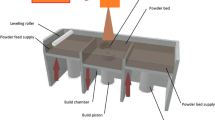Abstract
High Speed Sintering is an additive manufacturing process that creates parts by combining inkjet printing and infra-red lamps rather than laser systems employed in Laser Sintering. This research investigated the effects of altering the dosage of ink (via grayscale/dithering) on the properties of parts produced from elastomers. The results indicate that print density may be optimized to maximize mechanical properties and have achieved an elongation at break as high as 365 pct. The findings also open up the possibility of creating parts with added functionality. Using differing amounts of ink per layer it may be possible to create parts with varying properties throughout.







Similar content being viewed by others
References
ASTM International: Standard Terminology for Additive Manufacturing Technologies, 2012.
N. Hopkinson, R. Hague, and P. Dickens: Rapid manufacturing: an industrial revolution for the digital age, Wiley, 2005.
Thomas, H. R.; Hopkinson, N.; Erasenthiran, P. In Solid Freeform Fabrication Symposium University of Texas, Austin, USA, 2006, p 682.
Hopkinson, N.; Erasenthiran, P. In Solid Freeform Fabrication Symposium University of Texas, Austin, USA, 2004, p 312.
Ellis, A.; Noble, C. J.; Hartley, L.; Lestrange, C.; Hopkinson, N.; Majewski, C. Journal of Materials Research 2014, 29, 2080.
Majewski, C. E.; Oduye, D.; Thomas, H.; Hopkinson, N. Rapid prototyping journal 2008, 14, 155.
Noble, C. J.; Ellis, A.; Hopkinson, N. In Solid Freeform Fabrication Symposium University of Texas, Austin, USA, 2014, p 132.
K. Herrmann: Hardness Testing: Principles and Applications; ASM International, 2011.
Ellis, A.; Noble, C. J.; Hopkinson, N. Additive Manufacturing 2014, 1-4, 48.
R.W. Chabay, B.A. Sherwood: Matter and Interactions; John Wiley & Sons, New York, 2011.
ASTM International: Standard Test Method for Rubber Property-Durometer Hardness, 2010.
Vasquez, M.; Haworth, B.; Hopkinson, N. Polymer Engineering & Science 2013, 53, 1230.
Lu, G.; Lu, G. Q.; Xiao, Z. M. Journal of Porous Materials 1999, 6, 359.
ASTM International: Standard Test Method for Tensile Properties of Plastics, 2010.
Author information
Authors and Affiliations
Corresponding author
Additional information
Manuscript submitted October 2, 2014.
Rights and permissions
About this article
Cite this article
Ellis, A., Hartley, L. & Hopkinson, N. Effect of Print Density on the Properties of High Speed Sintered Elastomers. Metall Mater Trans A 46, 3883–3886 (2015). https://doi.org/10.1007/s11661-015-2833-4
Published:
Issue Date:
DOI: https://doi.org/10.1007/s11661-015-2833-4




